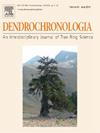Tree-ring based growth modelling to aid timber management of congeneric Aspidosperma and Handroanthus species along a seasonal tropical forest gradient
IF 2.3
3区 农林科学
Q1 FORESTRY
引用次数: 0
Abstract
Tropical dry forests (TDF) are vital carbon sinks, yet they are increasingly threatened by the effects of climate and land-use activities. In Brazil, law-based management practices in these forests do not ensure the sustainable use of these ecosystems, leaving them highly vulnerable. Here we use tree-ring widths to calculate cumulative diameter growth and estimate the ages at which trees congeneric species of Aspidosperma and Handroanthus reach the minimum logging diameter (MLD) across a gradient TDF types in northeastern Brazil (evergreen forest, savanna, and dry forests). Using the Growth-Oriented Logging (GOL) approach, we estimated the optimized MLD and logging-cycle length for each species from the current and mean annual increment curves for each species. Finally, we modeled tree-growth trajectories of each species and simulated timber yields at the next logging cycle under different scenarios (by law, by GOL, and in more stringent scenarios). Our results demonstrate that species from dry forests exhibit the slowest growth rates and the longest recovery times compared to species in other forest types. Only Aspidosperma castroanum from the evergreen forest approached sustainable yield levels under our simulations (∼80 %), while yields for the other species were much lower (10–30 %). These findings emphasize the need for forest management practices that account for tree growth variations between species and forest types. The prospects for sustainably extracting timber in the dry forests are bleak and a combination of increased logging cycle lengths and lower logging intensities are needed to ensure that timber stocks in these forests are not overexploited.
基于树木年轮的生长模型,以帮助沿季节性热带森林梯度的同属蛛形草和手花属物种的木材管理
热带干林是重要的碳汇,但它们日益受到气候和土地利用活动影响的威胁。在巴西,基于法律的森林管理实践不能确保这些生态系统的可持续利用,使它们非常脆弱。本文利用树木年轮宽度计算了巴西东北部不同梯度TDF类型(常绿森林、稀树草原和干旱林)中蛛形草属(Aspidosperma)和手花属(Handroanthus)的累积直径生长,并估算了其达到最小采伐直径(MLD)的年龄。利用生长导向测井(GOL)方法,从各树种的当前和平均年增量曲线估计出各树种的最优MLD和采伐周期长度。最后,我们模拟了每个树种的树木生长轨迹,并模拟了不同情景(按法律、按GOL和更严格的情景)下一个采伐周期的木材产量。研究结果表明,相对于其他森林类型的物种,来自干旱森林的物种表现出最慢的生长速度和最长的恢复时间。在我们的模拟下,只有常绿森林中的castroanum接近可持续产量水平(~ 80 %),而其他物种的产量要低得多(10-30 %)。这些发现强调,需要采取森林管理措施,考虑到树种和森林类型之间的树木生长差异。在干燥森林中可持续地采伐木材的前景是暗淡的,需要增加采伐周期长度和降低采伐强度,以确保这些森林中的木材资源不会被过度开采。
本文章由计算机程序翻译,如有差异,请以英文原文为准。
求助全文
约1分钟内获得全文
求助全文
来源期刊

Dendrochronologia
FORESTRY-GEOGRAPHY, PHYSICAL
CiteScore
5.50
自引率
13.30%
发文量
82
审稿时长
22.8 weeks
期刊介绍:
Dendrochronologia is a peer-reviewed international scholarly journal that presents high-quality research related to growth rings of woody plants, i.e., trees and shrubs, and the application of tree-ring studies.
The areas covered by the journal include, but are not limited to:
Archaeology
Botany
Climatology
Ecology
Forestry
Geology
Hydrology
Original research articles, reviews, communications, technical notes and personal notes are considered for publication.
 求助内容:
求助内容: 应助结果提醒方式:
应助结果提醒方式:


